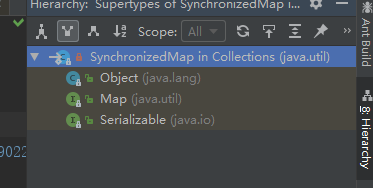了解到Java8以后HashMap的实现换了,也看了很多博客一直在向我这个小菜鸡说HashMap的重要。因此我决定洗心革面,好好正视HashMap
- 基于jdk 8
先从类注释开始入手学习,顺便提高提高英文水平。如果有任何错误欢迎指出,thanks
* Hash table based implementation of the <tt>Map</tt> interface. This * implementation provides all of the optional map operations, and permits * <tt>null</tt> values and the <tt>null</tt> key. (The <tt>HashMap</tt> * class is roughly equivalent to <tt>Hashtable</tt>, except that it is * unsynchronized and permits nulls.) This class makes no guarantees as to * the order of the map; in particular, it does not guarantee that the order * will remain constant over time.
这段注释说,Hashmap基于hash表实现了map接口,并且提供了Map中的所有方法。key,value 允许为null.Hashmap可以粗略的等同与HashTable,但是不同的是HashMap是线程不安全的,并且允许为null.Hashmap并不保证map的顺序.
知识点
- HashMap的<key,value>都允许为null
- 额,这一点,思考了一下还是觉得写段代码验证验证,毕竟代码不会骗我
-
@Test public void TestnullValue() { Map<String, String> map = new HashMap(); map.put(null,null); map.put("2", "tony"); System.out.println(map.toString()); }
结果
{null=null, 2=tony}好吧,看来编写HashMap的前辈,木有骗我
- HashMap线程不安全
- HashMap无序
* <p>This implementation provides constant-time performance for the basic * operations (<tt>get</tt> and <tt>put</tt>), assuming the hash function * disperses the elements properly among the buckets. Iteration over * collection views requires time proportional to the "capacity" of the * <tt>HashMap</tt> instance (the number of buckets) plus its size (the number * of key-value mappings). Thus, it's very important not to set the initial * capacity too high (or the load factor too low) if iteration performance is * important.
emem...说实话读到这一段的时候,我有点难受...要不是我天生聪慧(英文太烂),我可能会被拍死在注释中
如果hash函数把元素正确的放在容器中,HashMap提供了耗费常量时间的操作, put 和get。迭代整个集合试图耗费的时间与容器的大小有关。因此不要为HashMap设置一个太高的初始值(或者太低的负荷系数)
负荷系数是扩容的时候需要用到的
知识点:
- 理想情况下HashMap的get, put的时间复杂度是O(1)
什么情况下不是O(1)呢?当发生Hash冲突的时候,时间复杂度就不是O(1)了
* <p>An instance of <tt>HashMap</tt> has two parameters that affect its * performance: <i>initial capacity</i> and <i>load factor</i>. The * <i>capacity</i> is the number of buckets in the hash table, and the initial * capacity is simply the capacity at the time the hash table is created. The * <i>load factor</i> is a measure of how full the hash table is allowed to * get before its capacity is automatically increased. When the number of * entries in the hash table exceeds the product of the load factor and the * current capacity, the hash table is <i>rehashed</i> (that is, internal data * structures are rebuilt) so that the hash table has approximately twice the * number of buckets.
影响HashMap性能的因素有两个,容量和负荷因子。
初始容量是创建hash表的时候就确定的,负荷因子用来判断是否允许自动扩容。当hash表中的数量超过容器的大小*负荷因子的时候.Hash表要再做一次内部构建,扩容为原来的两倍.
* <p>As a general rule, the default load factor (.75) offers a good * tradeoff between time and space costs. Higher values decrease the * space overhead but increase the lookup cost (reflected in most of * the operations of the <tt>HashMap</tt> class, including * <tt>get</tt> and <tt>put</tt>). The expected number of entries in * the map and its load factor should be taken into account when * setting its initial capacity, so as to minimize the number of * rehash operations. If the initial capacity is greater than the * maximum number of entries divided by the load factor, no rehash * operations will ever occur.
一般负荷因子的数值是0.75 它平衡了时间和空间复杂度。 负载因子值越大空间开销越大,但是查找的开销就越低。HashMap的绝大部分操作都是Get Put,
当哈希表中entry的总数少于负载因子和初始容量乘积时, 就不会发生rehash(内部重新构建)动作
* <p>If many mappings are to be stored in a <tt>HashMap</tt> * instance, creating it with a sufficiently large capacity will allow * the mappings to be stored more efficiently than letting it perform * automatic rehashing as needed to grow the table. Note that using * many keys with the same {@code hashCode()} is a sure way to slow * down performance of any hash table. To ameliorate impact, when keys * are {@link Comparable}, this class may use comparison order among * keys to help break ties. *
如果有大量的数值需要被存储到HashMap中,那么要确保初始够大,防止map rehash自动扩容增大开销。
使用大量keys转换后的hash地址相同会降低hash表的效率,因此当keys支持java.lang.Comparable的时候,可以利用排序降低影响。
* <p><strong>Note that this implementation is not synchronized.</strong> * If multiple threads access a hash map concurrently, and at least one of * the threads modifies the map structurally, it <i>must</i> be * synchronized externally. (A structural modification is any operation * that adds or deletes one or more mappings; merely changing the value * associated with a key that an instance already contains is not a * structural modification.) This is typically accomplished by * synchronizing on some object that naturally encapsulates the map.
HashMap是线程不安全的,如果多个线程同时访问hash map,至少有一个线程修改了表结构,那么必须加锁。
(改变表结构指的是,添加或删除一个或多个映射,如果是改变values值不是修改表结构)
当多个线程操作hashmap的时候,一般使用同步对象锁锁住map上
* If no such object exists, the map should be "wrapped" using the * {@link Collections#synchronizedMap Collections.synchronizedMap} * method. This is best done at creation time, to prevent accidental * unsynchronized access to the map:<pre> * Map m = Collections.synchronizedMap(new HashMap(...));</pre>
如果不存在这样的对象时,应该调用Collections.synchronizedMap把HashMap转化成线程安全的SynchronizedMap
public static <K,V> Map<K,V> synchronizedMap(Map<K,V> m) { return new SynchronizedMap<>(m); }

* * <p>The iterators returned by all of this class's "collection view methods" * are <i>fail-fast</i>: if the map is structurally modified at any time after * the iterator is created, in any way except through the iterator's own * <tt>remove</tt> method, the iterator will throw a * {@link ConcurrentModificationException}. Thus, in the face of concurrent * modification, the iterator fails quickly and cleanly, rather than risking * arbitrary, non-deterministic behavior at an undetermined time in the * future.
iterators会返回所的集合视图方法。如果iterator迭代器被创建了以后,map修改了表结构(除了iterator自身的remove),iterator会抛出ConcurrentModificationException异常。因此在并发修改的时候修改表结构操作会失败
@Test public void test() { Map<String, String> map = new HashMap(); map.put("1", "tony"); map.put("2", "tony"); Set<Map.Entry<String, String>> entries = map.entrySet(); Iterator<Map.Entry<String, String>> iterator = entries.iterator(); while (iterator.hasNext()) { if (iterator.next().getKey().equals("1")) { //不报错 iterator.remove(); //报错 map.put("3", "tony"); } } System.out.println(map.toString()); }